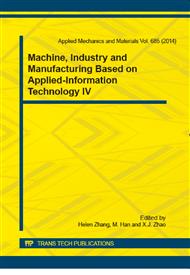[1]
I. Molina, J.N.K. Rao: Small area estimation of poverty indicators. Canadian Journal of Statistics, Vol 38(3) (2010), p.369–385.
DOI: 10.1002/cjs.10051
Google Scholar
[2]
W.S. CHAN: Maximum Likelihood Estimation Mixed Models Using Monte Carlo to Small Area Estimation in Generalized Linear Methods: Application of Breast Cancer Mortality. Applied Probability and Statistics (in Chinese), Vol 22(1) (2006), pp. l-22.
Google Scholar
[3]
L.P. Liu. S.Q. Pan and X.M. Ren: Small Area Estimation of Disability Base on Hierarchical Bayesian Statistics. Statistical Research (in Chinese), Vol. 27(3) (2010), pp.83-88.
Google Scholar
[4]
J.N.K. Rao: Small Area Estimation Hoboken[ M]. New York: Wiley, (2003).
Google Scholar
[5]
M. Pratesi and N. Salvati: Small area estimation: the EBLUP estimator based on spatially correlated random area effects. Stat. Meth. & Appl., Vol. 17(1) (2008), p.113–141.
DOI: 10.1007/s10260-007-0061-9
Google Scholar
[6]
H. Li andP. Lahiri: An adjusted maximum likelihood method for solving small area estimation problems. Journal of Multivariate Analysis, Vol. 101(4) (2010), pp.882-892.
DOI: 10.1016/j.jmva.2009.10.009
Google Scholar
[7]
R. E. Fay III and R. A. Herriot: Estimates of Income for Small Places. An Application of James-Stein Procedures to Census Data [J]. Journal of the American Statistical Association, Vol. 74(366a) (1979), pp.269-277.
DOI: 10.1080/01621459.1979.10482505
Google Scholar
[8]
Y.T. Zhang: Spacial Statistics. Statistics Education(in Chinese), Vol. 10(1)(1996), pp.35-40.
Google Scholar
[9]
D. Bates, M. Mächler and B. Bolker: Fitting linear mixed-effects models using lme4[J]. Journal of Statistical Software (forthcoming), (2012).
DOI: 10.18637/jss.v067.i01
Google Scholar
[10]
T. A. Davis: Direct Methods for Sparse Linear System. Fundamentals of Algo. SIAM, (2006).
Google Scholar
[11]
D. Bates: Mixed-effects modeling with R [EB/OL](2010). information on http: /lme4. r-forge. r- project. org/lMMwR/lrgprt. pdf.
Google Scholar
[12]
D.A. Harville andD.R. Jeske: Mean squared error of estimation or prediction under a general linear model. Journal of the American Statistical Association, Vol. 87(419)(1992), p.724–731.
DOI: 10.1080/01621459.1992.10475274
Google Scholar
[13]
D. L. Zimmerman and N. Cressie: Mean squared prediction error in the spatial linear model with estimated covariance parameters . Annals of the institute of statistical mathematics, Vol. 44(1)(1992), p.27–43.
DOI: 10.1007/bf00048668
Google Scholar
[14]
J.F. Yang, M. Zhao and W.S. Hu: Web Software Reliability Analysis Based on NHPP Class Model(in Chinese). Computer Engineering Vol. 38(14)(2012). p.26—28.
Google Scholar
[15]
G. Sofronov: Spatial Approaches in Small Area Estimation. (2009) Information on http: / www. uow. edu. au/content/groups/public/@web/@inf/@math/ documents/web/uow054844. pdf.
Google Scholar


